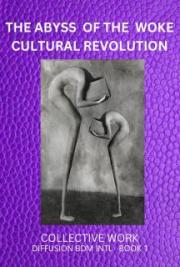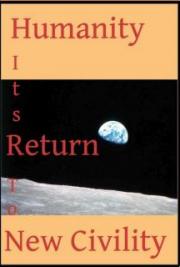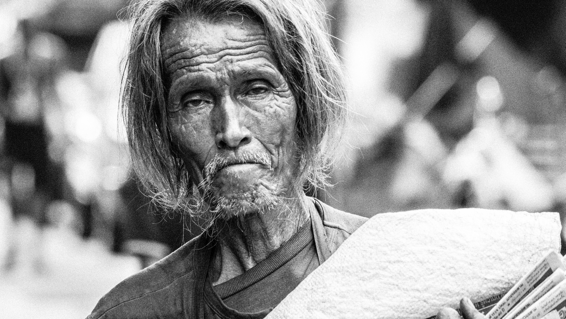
Dave John Cole
Poverty
Dedicated to all those in living in poverty, those without a home, those in need of help and finally those who dedicate their lives in the pursuit of helping those in need.
Regarding poverty, photography, this book and Thailand
My name is Dave John Cole. I am a photographer currently located in Bangkok, but originally from the UK.
First, let me begin with what this photography book is not. It is not associated with any charity. When I set out to take these photos it was as a photography study, not as an expose of the poverty and destitution in Bangkok. It’s not intended as some form of poverty handout, a graphic depiction of the poor in order to provide feelings of sadness, or to emotionally blackmail people to take action. It’s also not an abuse of the people in the photos for financial gain or recognition in the photography community.
So what is this? This is a portfolio of my photography work over the past 6 months. But over those months I have learnt that the pictures sometimes alone are not enough. Each photo has its own story. Each person has a story to tell, good or bad, and by combining these stories with my photography work, the result is something much more powerful and meaningful to me, and hopefully to others. It is to be shared freely, with or without credit to me. Some may interpret this as an ‘altruistic’
conundrum. I, too, have thought long and hard on this, and I have nothing to say but that I do what I do because of who I am.
Poverty is rife in Thailand. There are those who visit Bangkok and consider it to be an amazing and well developed city. But behind the major places to visit, there are so many areas full of people living next to canals, train tracks or abandoned land. These people are desperate. But they are also some of the most strong-willed, hardworking and happy people I have ever had the fortune to meet.
Do not be fooled by the signs for Chanel, LV or glitzy rooftop bars. Less than 1% of Thailand’s population own over 90% of its wealth. And this is something that Thailand deeply wants to hide from public view. The man driving the Ferrari wants no recognition of this fact.
Some people will say things like, “But Dave, they are all mafia run”. My response is simple. This does not negate their poverty, and only fuels the desperate situation they are in.
I hope those of you who read this book and view my photos will develop both an appreciation for the art of photography as well as a new understanding of those people we see every day living in poverty. The people in the book are all in Bangkok, but in every city in every country the same situation exists. Think on that, what harm could possibly come from considering a truth?
Dave John Cole
June 2014
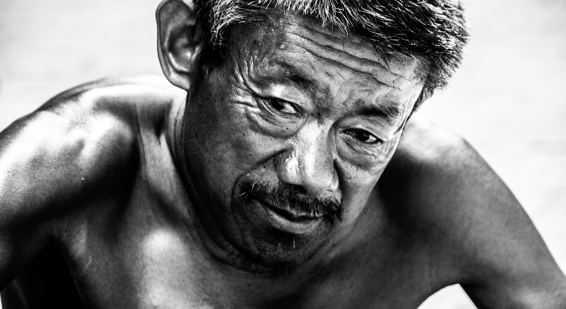
Begging
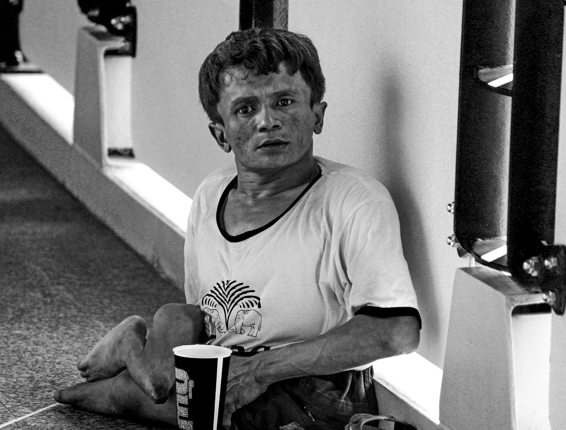
Shock Tactics
This is such a common sight in central Bang-
kok. Often on foot bridges and skywalks, se-
verely disabled people will be sat with a small
cup asking for money. This man I have seen
in multiple locations around tourist areas in
Bangkok. When I took this photo I needed to
prepare the right lens, and he spotted me be-
fore I could take my photo. This can be either
a blessing or a curse in street photography. In
this case I find so much power in his eyes, his
face as I photographed him. I did not approach
him for conversation, as I felt the distance and
separation between subject and photographer
has a message in itself. A reality.
A point about this I would like to make is that
there are many disabled beggars like this
spread all over Bangkok. Some I have seen with
no arms or legs, holding a cup in their mouth.
You may wonder how this is possible. Well, I
have been witness to the early morning drive
of a pickup truck, and loaded in the back are
disabled people in extremely poor condition.
Dirty bandages, weeping sores, expressions of
pain. These people are driven to various loca-
tions in central Bangkok, and they are carried
out of the van and placed on bridges and side-
walks to spend the day. Sometimes the van will
come back and move them to a different loca-
tion. At the end of the day, they are collected
and taken away again. The money they earn, I
leave you to speculate.
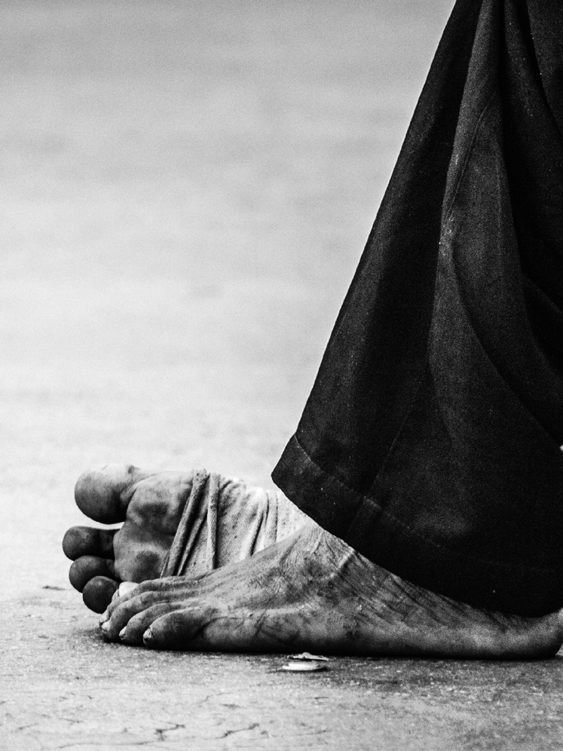
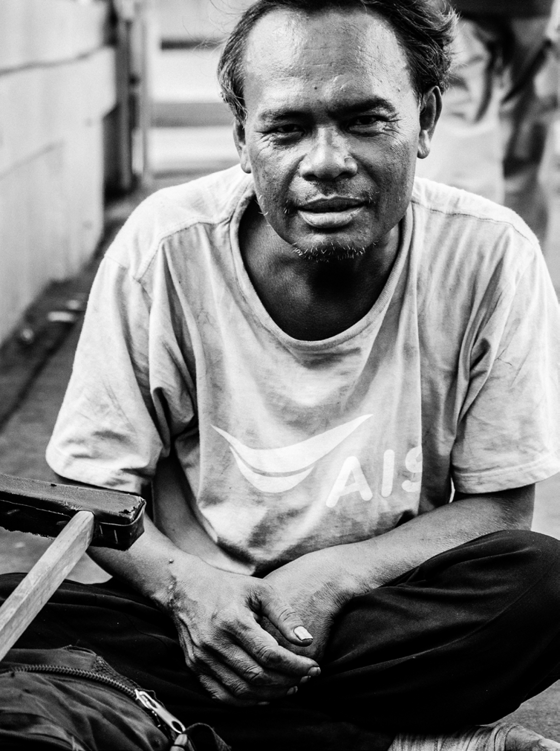
Cambodian in Bangkok
This man was sitting on a
bridge in a local area of
Bangkok. The bridge con-
nects to a large shopping
mall, and has a constant
flow of traffic so it is prime
for begging. However
what most foreigners fail
to realize is that there are
a considerable number of
Cambodian people home-
less on the streets of Bang-
kok. This particular man I
discovered had fled Cam-
bodia after being without
work, and begging would
not be accepted. He came
to Thailand illegally and af-
ter looking for work ended
up on the street. His foot
was bandaged and dirty,
and he struggled to walk.
A fact to consider is that
most Thais will not give
money to foreign beggars.
Their justification being ”a
Thai person would never
end up in such a position”.
How sad that such as an
attitude is accepted as cor-
rect in everyday society.
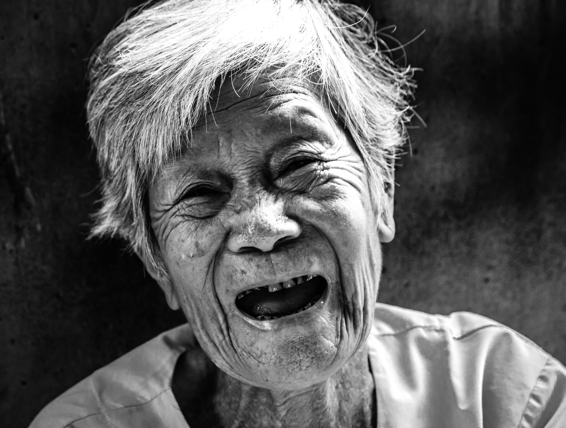
The elderly
I loved meeting and photographing this old
lady. She was sat in a narrow street in the
Chinatown district of Bangkok. I passed her
and immediately saw her smile. Consid-
er this, she is an old lady with nothing but
the empty cup in front of her, she has no
possessions, no home. She was not sat in
a tourist area where she could earn a lot.
But the entire time before, during and af-
ter photographing her, she was smiling and
laughing. She was happy.
There was a street vendor directly behind
me conversing with her. As I can speak Thai,
I noticed how gently the vendor spoke to
her and with such respect. In Thailand, if
anyone is older than you, you must perform
the Thai Wai in a different way, and use the
word “Pi” as an acknowledgment of them
being older and wiser. I have seen many
Thais talk to beggars in such a derogatory
tone, failing to use polite words or even us-
ing Thai words like ‘mung’ which is translat-
ed as “you”, but is extremely rude in public
conversation, especially with a stranger.
This photo always reminds me how we can
complain so much about our first world
problems, yet here is a woman with noth-
ing at all who has the one thing we want,
happiness.
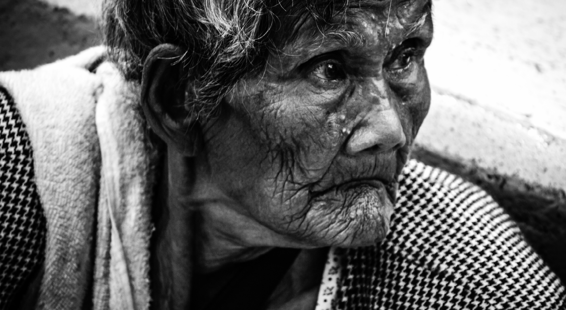
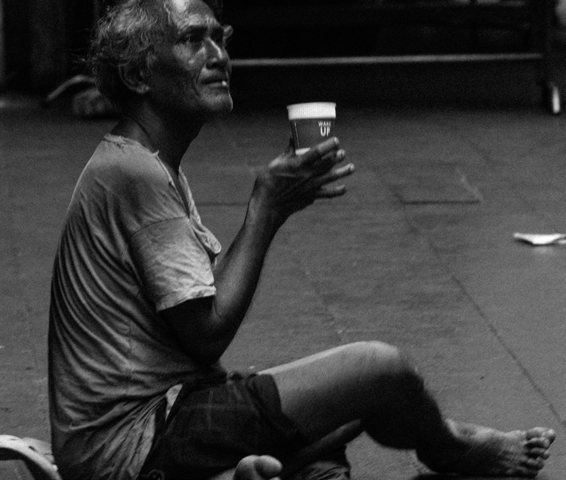
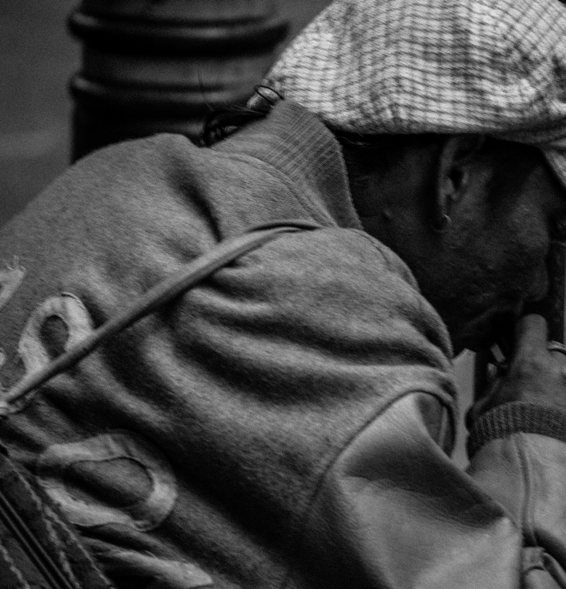
In plain sight
Silom is a main tourist hub in Bangkok. It hosts many different restaurants, shopping malls and the infamous Soi Pat Pong where Bangkok’s infamous bars are located.
However, it is also a center for business with many office workers. These two individuals I photographed from a distance. One is eating food from a trash bin. The other I watched for 10 minutes as he pleaded to Thai office workers to offer him money.

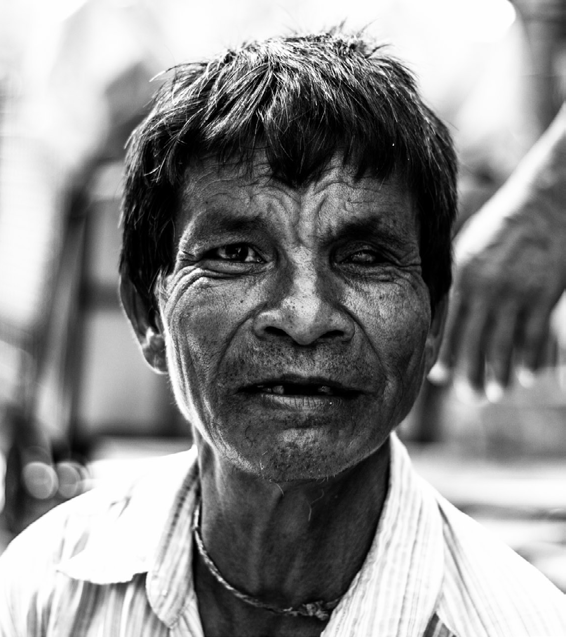
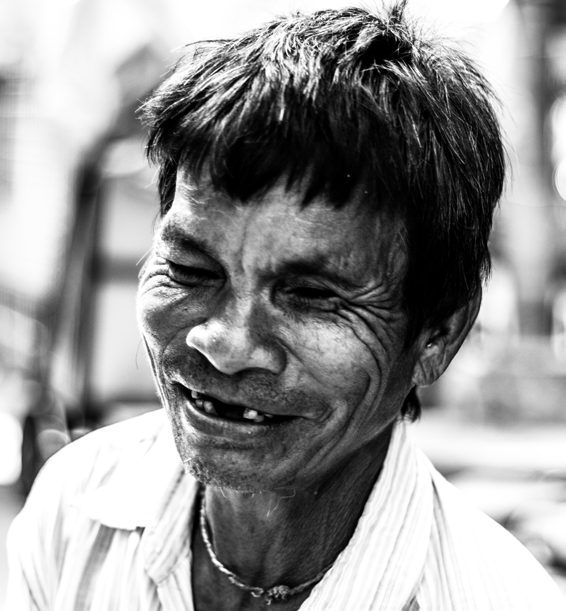
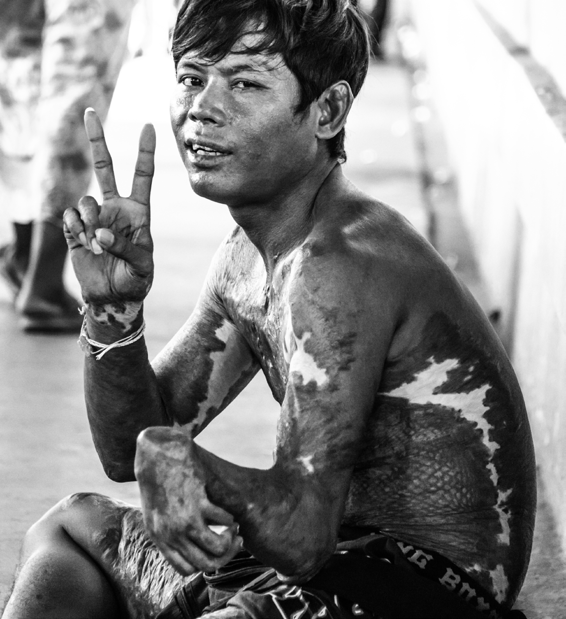
Sukrit
This is a difficult passage for me to write, and even more difficult for me to look at these photographs, as I am reminded of the 30 minutes I spent talking to him, where I literally sat my camera down and switched it off. After listening to his story, I couldn’t help but feel so sad and shocked.
This is Sukrit’s story.
Sukirt is 34 years old. 3 years ago, he worked in a factory just 1 kilometer from the bridge where this photo was taken. There was an accident. He was badly burnt, 70% percent of his body received first degree burns. He was rushed to a government hospital where they bandaged him, and treated his burns. You can see the imprint of the gauze they used on his left side. Once he was stable, due to lack of medical insurance, he was dis-charged from the hospital.
His employer refused to give any financial aid, and terminated his employment. His friends distanced themselves from him. He managed to raise enough funds for a simple skin graft from his leg to his right side. This operation cost B200,000 ($6,000). Shortly after this his wife left him. She also left his two children under his care.
Since that time, he has worked on that bridge, asking for money. His left arm is so badly burnt that it is fused in that position, and his inner arm is fused to the skin on his chest.
He is in constant pain, and when walking his left leg is locked and painful to stand on.
For 3 years he has worked on that bridge. He told me can earn anything between 100 to 300 baht a day. He needs at least B500 so he can buy food for himself and his children, and secure a roof over their heads each night at a local shelter. He told me during the day his children go to school, and then come stay with him on this bridge.
When I asked him how much it would cost to get the proper medical treatment he told me it would be over 1 million baht just to fix his arm. I then asked him what he will do.
He looked visibly upset and said, “What can I do but look after my children”.
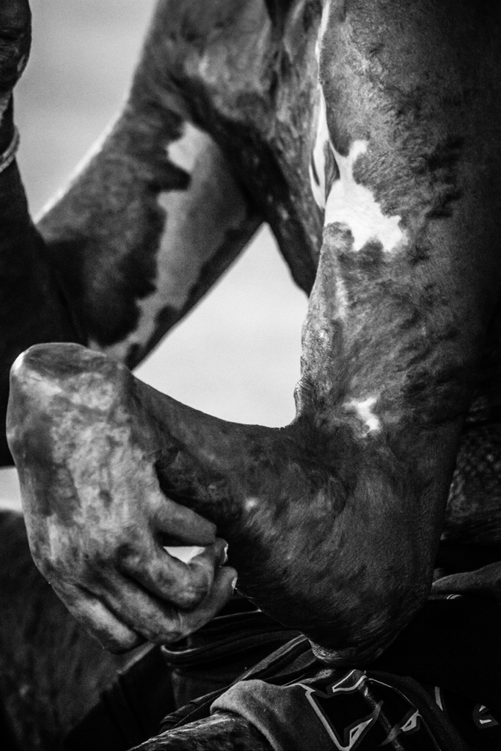
The Klong
There are many areas in Bangkok where the homeless gather to create a shelter for themselves. The Thai word “Klong” means canal, and this particular canal is in an area called Sanam Luang, which is right next door to the Royal Palace and the Royal Temples. It is hidden away down a small side street, away from public view, and stretches for about 2 kilometers.
On my first visit I entered the soi (street) running next to the Klong and was immediately struck by how many people were lying in the street asleep. They were lying on anything they could find, old newspapers, flattened cardboard boxes, old rags. Next I saw a multitude of small homes built out of nothing but cardboard, rotten wood and discarded fabric. No doors, the inside of these people’s homes open to see. I did not expect it to be such a graphic example of poverty, and it left me feeling quite emotional by the time I left.
As I ventured further I was unsure how I was going to be treated, being a white foreigner with a camera and photography bag.
But it was an amazing and surreal experience, because for the next 2 hours I approached people to take photos and they smiled and kindly spoke to me, not as a stranger, but as someone very welcome in this place. People even approached me, offering me help and guidance about where I should go, streets that were dead ends, and interesting people I could photograph. Where in the world could you go to such a place, and feel no fear of crime or violence, but be welcomed and feel, ironically, at home?
These are but a few of close to 200 photos I took that day.
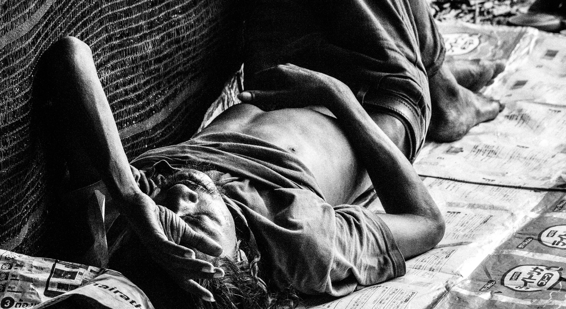
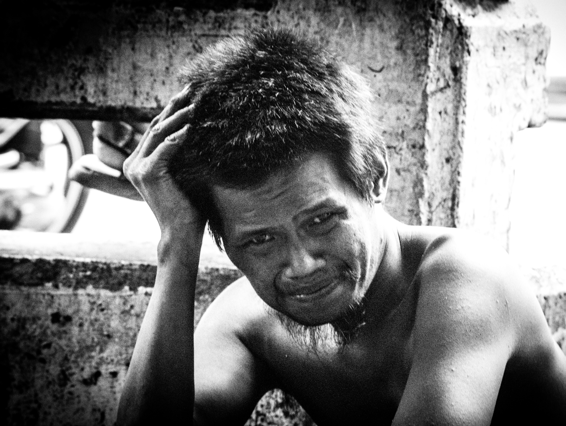
Autistic Treatment
As I wandered around the Klong, there was
a small shack that had been turned into a
street restaurant. Sitting outside was this man
dressed only in his underwear, crouched over
the ground and picking up dirt and arranging
it in some order only known to him.
I have had experiences with people suffering
from severe autism before. But in this case I
had no idea just how affected he was. I tried
to use a zoom lens to capture him from a dis-
tance, but was immediately approached by
the owner of this restaurant and told I could
enter and take photos of him close up.
I did so, and introduced myself to him. He be-
came very distressed at my presence, sweep-
ing away dirt from the floor and covering his
face. I immediately knew I should leave, but
at this point a man walked up to him and said,
“look into the camera,” and began kicking him.
What do you do as a photographer in this
situation? It is shameful, but I took this one
photo, then told the man to stop what he was
doing and left quickly.
Mental illness in most of Thailand is not treat-
ed correctly, and many people are considered
outcasts if they have such an illness. This poor
man, and his future, is always at the back of
my mind.
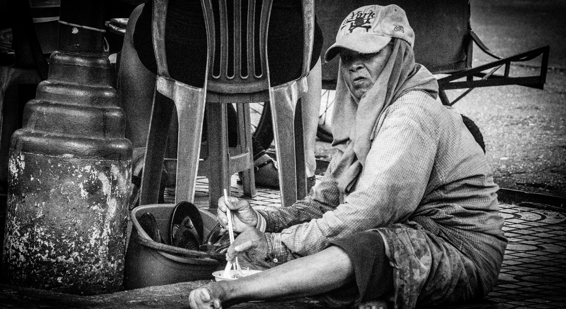
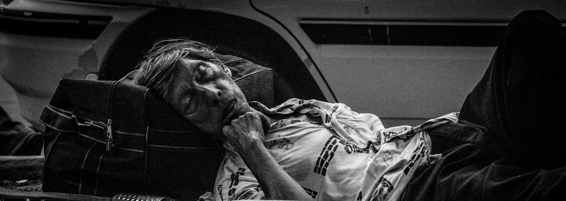

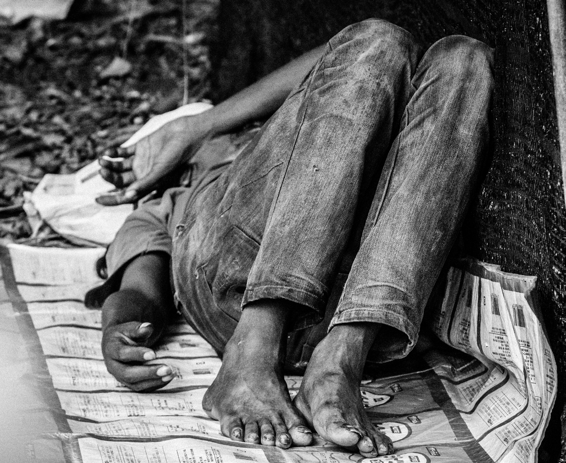
Yaba
Drugs are a very prevalent part of street life in Thailand.
In particular, Yaba, a kind of methamphetamine mixed
with caffeine. It is very cheap and often used by the
homeless. It can be swallowed as a pill, or smoked. Most
importantly, it is extremely addictive, and its effects can
vary from acting like a stimulant for nearly 24 hours, to
producing maniacal and aggressive behavior. There are
often stories of people high on Yaba in mad rages, fight-
ing random strangers, or even killing people.
I was told by a passerby that this particular man was an
addict, and had in effect passed out after prolonged use
of the drug preventing him from sleeping. I was literally
standing over him and he had no idea I was there. Some-
times he would open his eyes, look at me, and then just
close them again.
There are many people like this on the Klong. Some are
alcoholics who sleep wherever they fall, but the majority
are “crashing” after prolonged use of Yaba.
Drug sentences in Thailand are harsh and inconsistent.
If the police were to find such a drug on you, you could
bribe the officer if you had enough money to avoid ar-
rest. But most do not have this ability. A technician who
worked in my building had police plant a single pill in
his pocket and asked for a bribe that he was unable to
produce. He was then immediately taken to a prison in
the north of Thailand for a 3 year sentence. Not even his
family was able to see him.
Newspaper Man
This old man, this frail and poverty stricken individual, was and is the catalyst for me making this book. He is both the inspiration for my continued efforts to photograph those in poverty and the motivation for my efforts to share with the world what poverty really is.
Let me start by saying that this man said nothing to me, even though I spent a long time sitting with him, asking him questions and taking photos. But he didn’t need to say anything, because all his responses could be summed up by the look in his eyes.
I discovered him walking down the Klong, carrying a bundle of old newspapers. When I say walking, his pace was so slow I was able to walk around a section of the Klong multiple times and he had progressed less than 20 meters. When I did return to him, he had chosen to sit on the sidewalk. I noticed the bundle of newspapers, all old copies. What he was doing with them I do not know, but no one in the Klong spoke to him or even acknowledged his presence.
I sat down, and began speaking in Thai, asking him things like what was his name, how old was he, where did he come from, what was he doing with these newspaper? No answer.
But throughout my questioning, he never looked away from me, just stared right back at me with those sad and broken eyes. After some time I reached out to touch his shoulder in comfort, and was immediately shocked. He was so thin you could feel all the bones pushing through his flesh. I couldn’t take my hand away, I had only ever felt such a thing when my grandfather was dying of terminal lung disease, and it immediately upset me on many different levels.
I reached into my pocket and took all the money I had and gave it to him, repeating over and over that he should find some food, get a room for the night and rest. It was only then that he broke his stare, looked at the money, then handed me his bundle of old newspapers. When I explained I wasn’t buying anything he just looked confused, stood up, and continued his slow walk down the Klong.
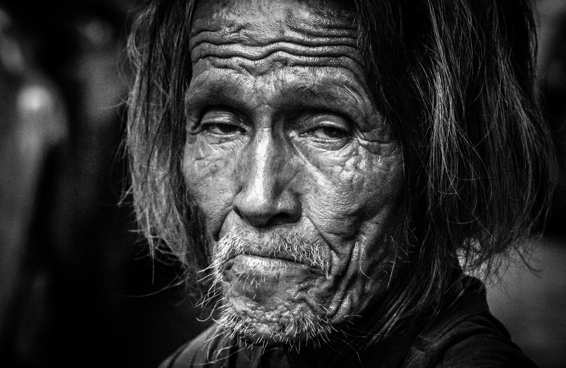
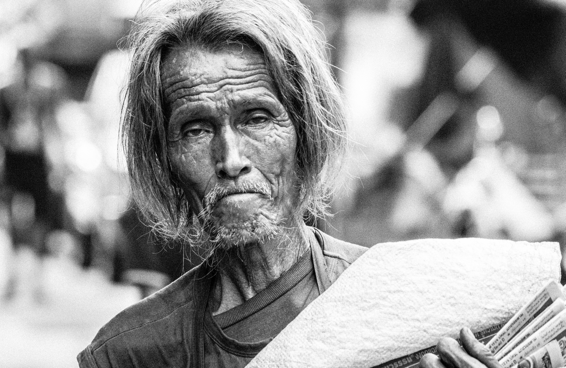
The disabled outcasts
I have already spoken of the disabled people living and working on the street in Bangkok. There is very little for me to add, as these photos speak for themselves.
But what I would like to say is that the people are people just like you and me. And these people not only feel the pain from poverty and homelessness, but pain from their disabilities. I once spoke to a man in the center of Bangkok about what he suffered from and made the mistake of stating that if he were on the streets like this in the UK, he would immediately be taken to a hospital and the government would look after all his medical treatment and financial support.
What an idiotic thing for me to say. The look of sadness and desperation on his face after I spoke was terrible.
I love Thailand as a country. But it is a harsh and unforgiving place, and one thing that distresses me the most about ‘Thai Culture’
is the treatment of disabled people.
The Thai Buddhist interpretation of Karma says, “that person must have been very bad in their previous life to be like that now.”
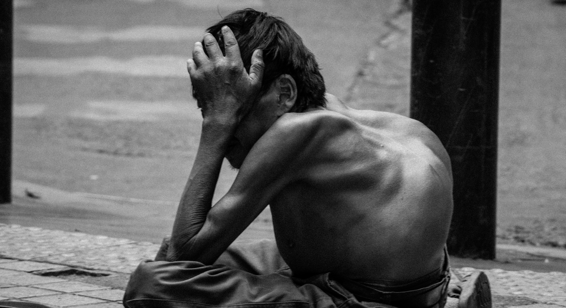
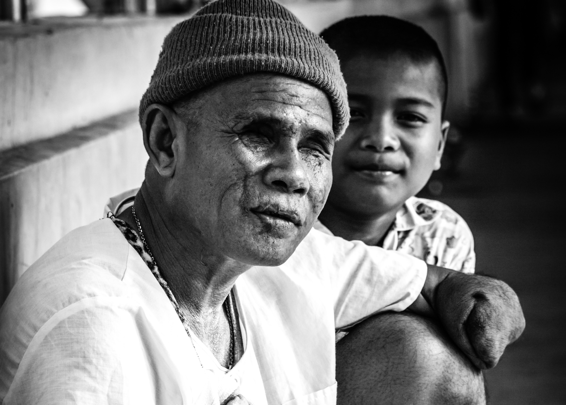
Family
This man was sat just down the bridge
from Sukrit. The boy next to him is his
son.
He is blind, with his eyes removed, and
has both arms amputated just below the
elbow. When I asked him if I could talk
to him, he kindly agreed and I sat on the
floor opposite him. He immediately told
me not to sit there, as it was dirty, and
as he was sat on a blanket, he shifted up
and told me to come sit next to him.
I spoke to him for a short while before
his son came up. He told me he was from
Cambodia, and could not remember
how many years he had been begging
in Thailand. He made money by playing
the harmonica, holding it between his
two stumps, every so often wiping his
mouth and the instrument with a rag
that hung from his neck.
When I asked if I could take a photo, his
response was priceless.
“Why would I mind if you took a photo,
I am blind.”
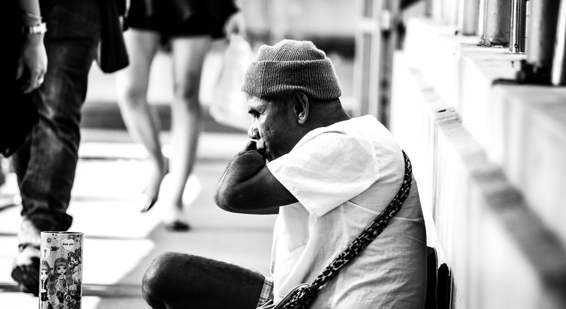
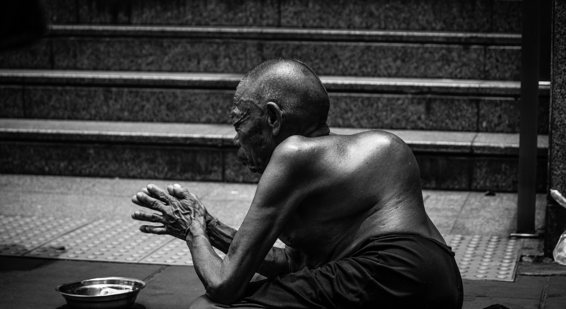
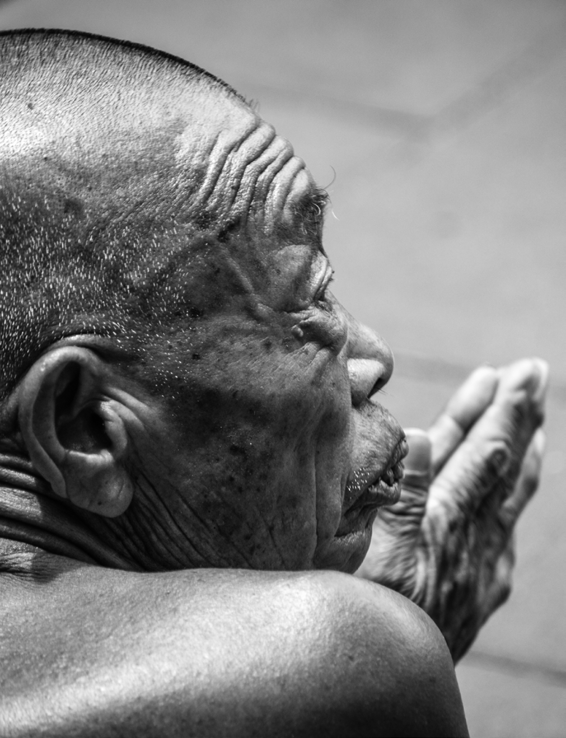
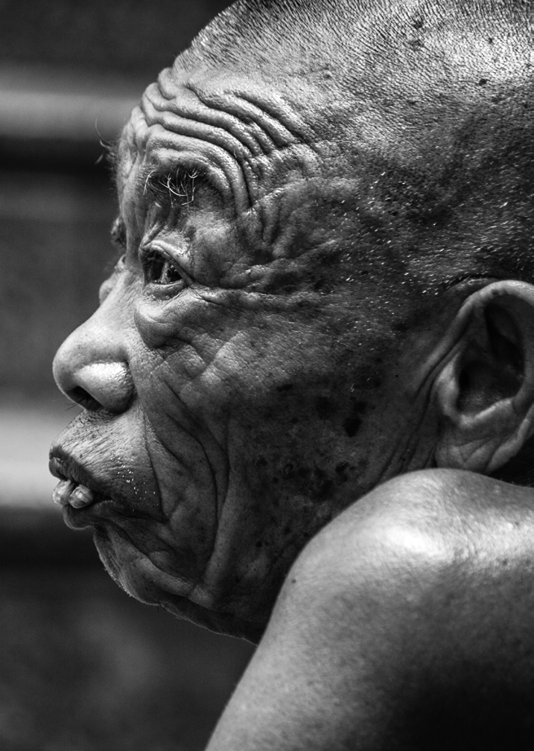
Train Station
This man was sat outside the
MRT station (subway) near the
main train station in Bangkok.
I remember this day because it
was mid-April, which is the hot-
test time in Thailand. The tem-
perature was close to 40 de-
grees, and he was sat in direct
sunlight.
I did not speak to him, only pho-
tographed him. But whilst I did
this there was a group of mo-
torcycle taxi drivers nearby who
became very interested in what
I was doing. I have stated before
that the mafia run these kinds
of people, but I can honestly say
these taxi drivers had nothing to
do with it.
After I finished photographing
him, I gave some money to him,
and asked one of the taxi driv-
ers to take me up the road. One
of them said it was a good thing
what I was doing, and they all
smiled and some even Wai’d me.
Feet
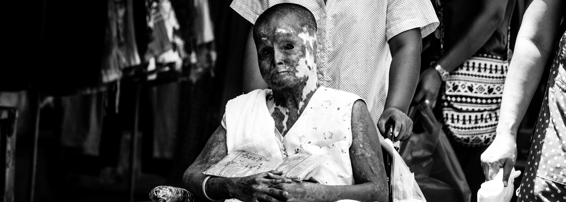
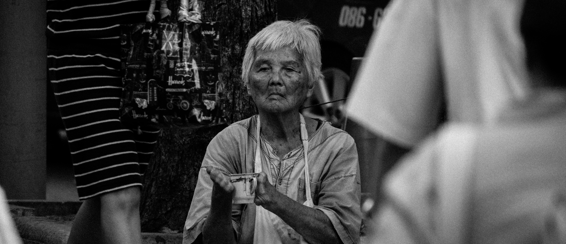
The slums
Klong Toey is an infamous area in Bangkok. Ask any Thai person or foreigner who lives here and they will know it. The media is always reporting on it; bomb blasts in the market, shootings, murders, mafia crime gangs… the list goes on.
I have lived in Bangkok for ten years and there is no place I haven’t been, except Klong Toey. I was always warned away, given advice like “if you enter you may not come out”, or that you would immediately get sick due to the nature of the slum there.
The slum itself is a packed group of hatched paths, very small to walk through, and is home to thousands of people living in poverty and destitution. One day in April I decided to go, and against all advice made my way through the market, asked a bike to take me (who resisted at first), and was left standing at the entrance, a small alleyway leading into the slum. When I asked the taxi driver if it was safe, he said, “Don’t worry, but get out before dark”.
My photography study for that day was to capture the most poverty stricken individuals I could, to see the faces of people suffering from crime, drugs, and illness. But when I entered, what I discovered was the exact opposite.
I walked down the alleyway, and was immediately greeted by everyone I walked past. People were laughing, going about their business. I wasn’t even noticed by some. I made it no further than 20 meters before I was stopped by a couple of old ladies who wanted me to sit, rest and chat with them.
What I found in that slum was something unexpected: Happiness, community, and contentment.
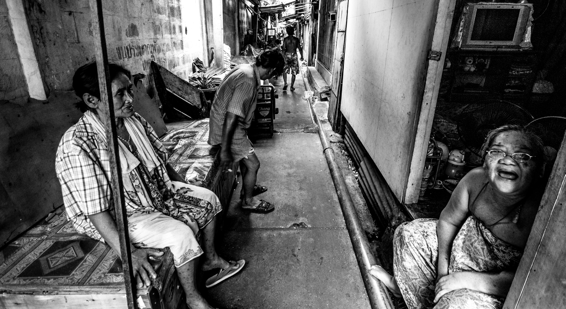
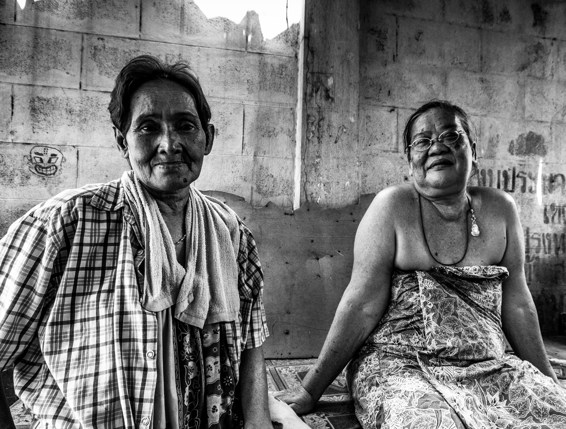
Floods, death and a stroke
These two old ladies were the first to stop
me in the slum, and ask me to sit and talk.
We spoke about life in the slum, and what
it was like to live there. The woman on the
right did most of the talking and was so kind
and always smiling and laughing.
She told me that three years ago her hus-
band had died during the worst floods Bang-
kok has ever suffered. He got typhoid from
dirty water, and died the next day. Two years
later, she had a paralyzing stoke and luckily
her friend (on the left) got her to a hospital
where she was treated for 3 days. The past
year she has been recovering, and gradual-
ly learning to walk again, although the right
side of her face has never recovered.
The most amazing thing she told me was
that she was fluent in English, but after the
stroke she lost all ability to speak it. When
I asked her if she could still understand it,
she said of course. So I proceeded to speak
to her in English with her replying in Thai
for 5 minutes.
Simply an amazing and inspiring woman.
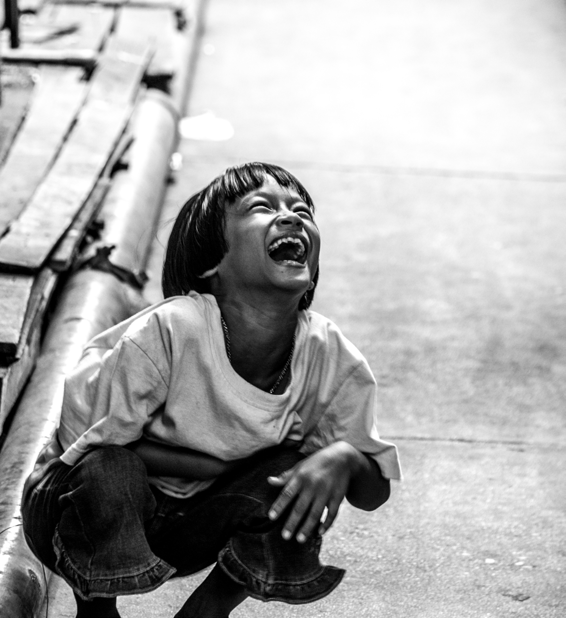
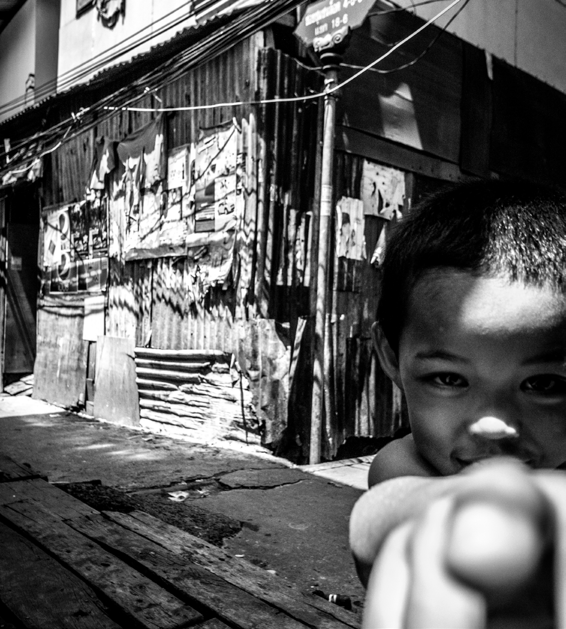
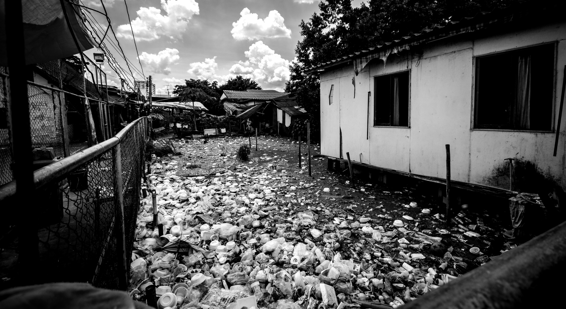
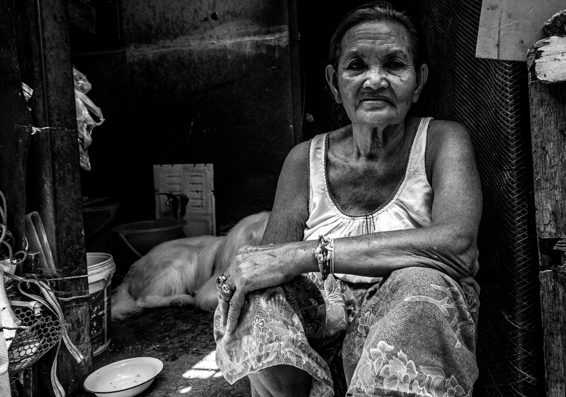
Never want to leave
I spoke to many people that day
in Klong Toey. This woman had
lived in the slum for 30 years, and
recently lost her husband.
She lived in a small shack, exact-
ly what you see behind her in the
picture. She has a grandson that
was visits her, but other than that
she j










































